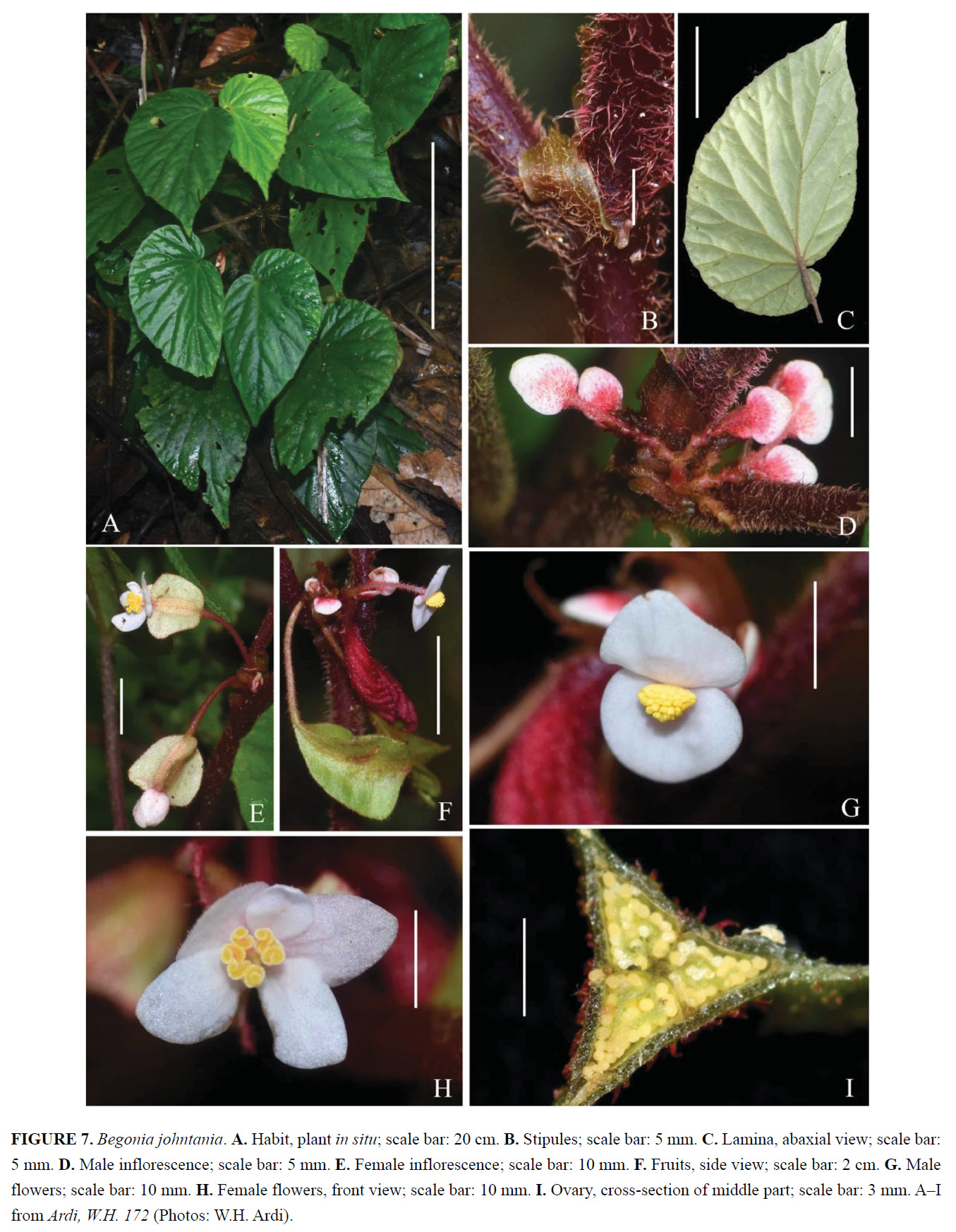Begonia johntanii in Phytotaxa 381(1): 39. 2018
Primary tabs

Diagnosis
- Begonia johntania is similar in habit and leaf shape to B. capituliformis Irmscher (1913: 354), but differs in having longer petioles (3–12 cm vs 3–5 cm), denticulate leaf margins (vs broadly dentate), adaxially glabrous leaves (vs sparsely bristly between or on the veins), paniculate-cymose male inflorescences (vs capituliform) and fruits on hanging, 2–2.8 cm long pedicels (vs fruit not pendulous,
pedicels 5–8 mm long). (Ardi, W.H., Chikmawati, T., Witono, J.R. & Thomas, D.C. (2018). A synopsis of Begonia (Begoniaceae) of Southeastern Sulawesi including four new species. Phytotaxa 381.1: 027-050.)
Description
- Perennial, monoecious herb, erect or appressed to substrate at the base and distally erect, to ca. 50 cm tall. Stem branched; internodes 3–12 cm long, brownish-reddish, covered with dense indumentum of bristly hairs up to ca. 1.5 mm long. Leaves alternate; stipules caducous, 8–15 × 4–6.5 mm, ovate to oblong, with an abaxially slightly prominent midrib, apex narrowed into bristle projecting up to 3 mm, concolourous with the stem, translucent at the margin, abaxially hairy; petioles 6–13 cm long, adaxially shallowly channelled, concolourous with the stem, hairy; lamina 10–18 × 6–10 cm, asymmetric, ovate to elliptic, base cordate and lobes not or just slightly overlapping, apex acuminate, margin denticulate, adaxial surface green, with red veins, glabrous, abaxial pale green, hairy; venation palmate-pinnate, primary veins 6–7, actinodromous, secondary veins craspedodromous. Inflorescences protogynous, internodes between female and male partial inflorescence strongly compressed; female inflorescences 2-flowered, peduncles ca. 1 mm long; male inflorescences compressed paniculate-cymose with 3−5 monochasial partial inflorescences, each with up to 7 flowers, bracts caduceus, not observed. Male flowers: pedicels 14–18 mm long, reddish, hairy; tepals 2, white, 6–9 × 5–7 mm, ovate, base slightly cordate, apex rounded, outer surface hairy with red trichomes; androecium of ca. 30–32 stamens, yellow, filaments up to ca. 0.5 mm long, slightly fused at the very base, anthers up to ca. 1 mm long, oblong to narrowly obovate, dehiscing through unilaterally positioned slits that are ca. ½ as long as the anthers. Female flowers: pedicels 1.5–2.5 cm long, reddish, hairy; tepals 5, white tinged pink, unequal, one smaller 6–7 × 3–4 mm, the four larger 8–10 × 5–6 mm, ovate to elliptic, outer surface hairy; ovary (excluding wings) 11–13 × 4–4.5 mm, ellipsoid, pale green, hairy with red trichomes, locules 3, placentation axile, placentae bilamellate, wings 3, equal, pale green, base rounded to cuneate, apex subtruncate to truncate, up to 7 mm at widest point (apically or subapically); style ca. 3.5 mm long, basally fused, 3–branched, each stylodium bifurcate in the stigmatic region, stigmatic surface a spirally twisted papillose band, orange. Fruits: peduncles ca. 2 mm long; pedicels 2–2.8 cm long, pendulous; seed-bearing part ellipsoid, 13–20 × 4.5–7 mm (excluding the wings), hairy, dehiscent, splitting along the wing attachment, wings shape as for ovary, up to 8 mm at the widest point (apically or subapically). Seeds barrel-shaped, ca. 0.2 mm long. (Ardi, W.H., Chikmawati, T., Witono, J.R. & Thomas, D.C. (2018). A synopsis of Begonia (Begoniaceae) of Southeastern Sulawesi including four new species. Phytotaxa 381.1: 027-050.)
Conservation
- Data Deficient (DD). This species is only known from a single locality; a forest remnant in close proximity to a village. The forests in the wider area are very poorly collected. Consequently, we assess this species as Data Deficient (IUCN 2012). (Ardi, W.H., Chikmawati, T., Witono, J.R. & Thomas, D.C. (2018). A synopsis of Begonia (Begoniaceae) of Southeastern Sulawesi including four new species. Phytotaxa 381.1: 027-050.)
Distribution (General)
- Indonesia; endemic to Sulawesi, Southeast Sulawesi (known only from the type locality). (Ardi, W.H., Chikmawati, T., Witono, J.R. & Thomas, D.C. (2018). A synopsis of Begonia (Begoniaceae) of Southeastern Sulawesi including four new species. Phytotaxa 381.1: 027-050.)A
Etymology
- The specific epithet is in honour of Mr. Tan Jiew Hoe, a patron of botanical exploration and plant taxonomy and generous supporter of the Begonia of Sulawesi project. (Ardi, W.H., Chikmawati, T., Witono, J.R. & Thomas, D.C. (2018). A synopsis of Begonia (Begoniaceae) of Southeastern Sulawesi including four new species. Phytotaxa 381.1: 027-050.)B
Notes
- The compressed paniculate-cymose male inflorescence is a rare character among Sulawesi Begonia. Prima facie, this inflorescence looks similar to the inflorescences of Begonia capituliformis from Northern Sulawesi. However, Begonia johntania has less compressed paniculate-cymose inflorescences with short internodes, while B. capituliformis has dense and strongly compressed subumbellate (capitulum-like) male inflorescences. Another difference is the length of the female flower pedicels and fruit pedicels: in B. johntania the fruits are pendulous on up to 2.8 cm long flower and fruit pedicels, while in B. capituliformis the female flower and fruit pedicels are much shorter (5–8 mm long) and the flowers and fruits are not pendulous. (Ardi, W.H., Chikmawati, T., Witono, J.R. & Thomas, D.C. (2018). A synopsis of Begonia (Begoniaceae) of Southeastern Sulawesi including four new species. Phytotaxa 381.1: 027-050.)

